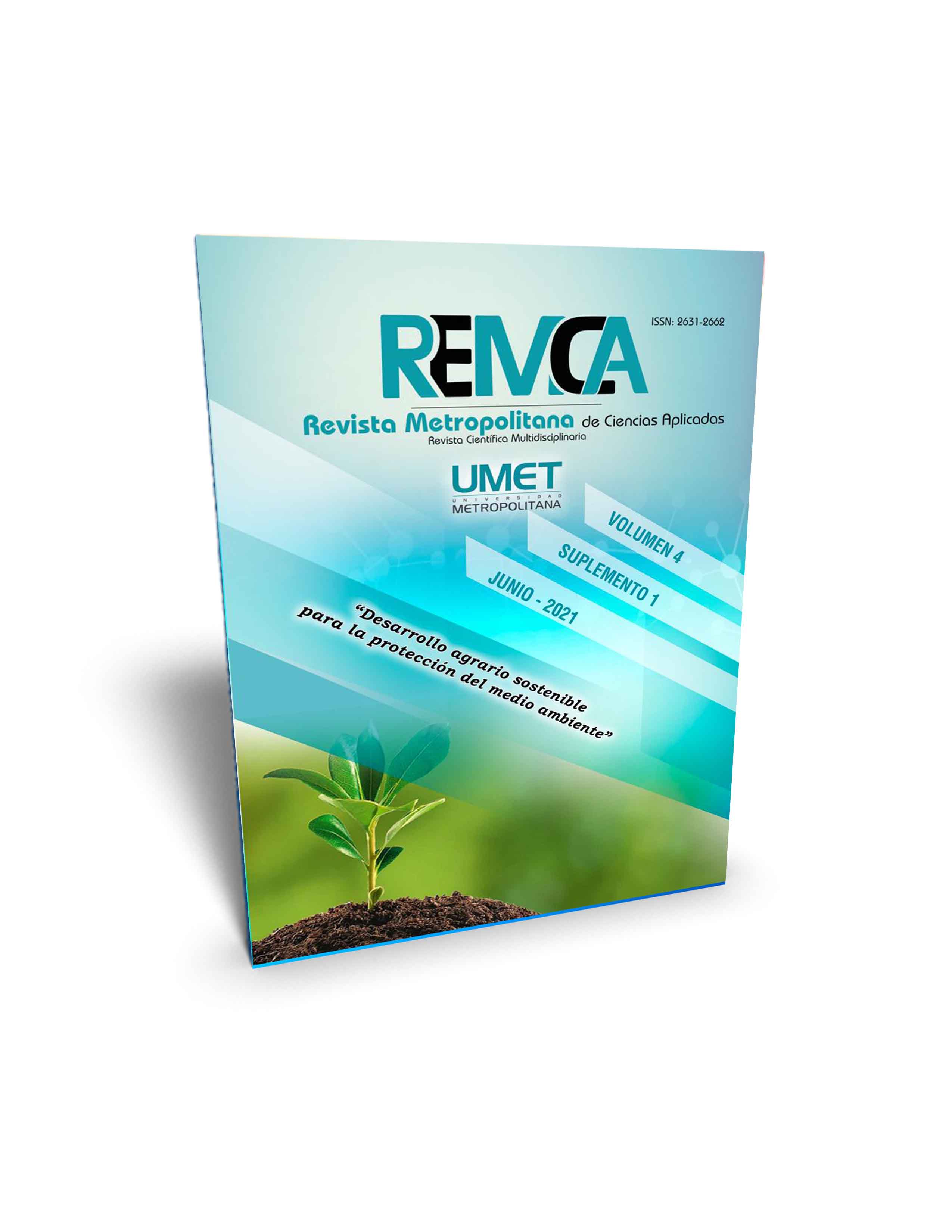Influence of nitrogen fertilization in different stages of development of the pepper crop (Capsicum annum L.)
DOI:
https://doi.org/10.62452/w8mzjz82Keywords:
Nitrogen fertilizer, SPAD, increasing doses, stagesAbstract
The study was conducted in areas of Granja Santa Inés, the experiment was based on the application of nitrogen fertilizer from two sources of nitrogen (N), 50% mineral and 50% organic; the experimental design was completely random blocks, four increasing doses of N (0-225-450-675 kg N ha-1) were evaluated. For vegetative variables the following characteristics were valued: fresh matter, chlorophyll, fruit number, fruit length, fruit width and for production variables: yield; 30% of the total N was applied during the first stage, 50% during the second stage and 20% during the final stage; for data collection was executed at the end of each stage at 37, 67 and 97 days after transplantation (DDT). For fresh matter accumulation data the highest weight was obtained at 97 days at a dose of 675 kg N ha-1 obtaining a total weight of 9 455.46 kg ha-1; while for the chlorophyll variable the highest value recorded in the same days was obtained with an average of 79.8 SPAD units. In performance, the best result was recorded at 97 days in treatment 4, with 4 005.31 kg ha-1
Downloads
References
Aliyu, L., Silva, C. P., & Lima, K. S. (2000). Effect of Organic and Mineral Fertilizers on Growth, Yield and Composition of Pepper (Capsicum annuum L.). Biological Agriculture and Horticulture, 18(1), 29–36.
Arias Montes, R. A. (2016). Respuesta agronómica de cultivo de pimiento (Capsicum annum) con la aplicación de abonos orgánicos foliares y edáficos. (Tesis de licenciatura). Universidad de Cotopaxi.
Bar-Tal, A., Aloni, B., Karni, L., Oserovitz, J., Hazan, A., Itach, M., Gantz, S., Avidan, A., Posalski, I., Tratkovski, N., & Rosenberg, R. (2001). Nitrogen nutrition of greenhouse pepper. I. Effects of nitrogen concentration and NO3:NH4 ratio on yield, fruit shape, and the incidence of blossom-end rot in relation to plant mineral composition. HortScience, 36(7), 1244–1251.
Casilimas, H., Monsalve, O., Bojacà, C. R., Gil, R., Villagràn, E., Arias, L. A., & Fuentes, L. E. (2011). Manual de pruducción de pepino bajo invernadero. Ministerio de agricultura y desarrollo rural.
Cerdas, R. (2014). Comportamiento productivo del pasto maralfalfa (Pennisetum sp.) con varias dosis de fertilización nitrogenada. Intersedes, 16(33).
Chungata Campoverde, A. E., Chungata Jiménez, K. E., Vite Cevallos, H. A., & Barrezueta-Unda, S. (2019). Perfil socioeconómico y ambiental de la Asociación Agraria Bananera fincas de El Oro. Revista Metropolitana de Ciencias Aplicadas, 2(2), 182-190.
Fontes, P. C. R., Dias, E. N., & Silva, D. J. H. da. (2005). Dinâmica do crescimento, distribuição de matéria seca e produção de pimentão em ambiente protegido. Horticultura Brasileira, 23(1), 94–99.
Ling, Q., Huang, W., & Jarvis, P. (2011). Use of a SPAD-502 meter to measure leaf chlorophyll concentration in Arabidopsis thaliana. Photosynthesis Research, 107(2), 209–214.
Novoa, R., & Villagrán, N. (2002). Evaluation of a chlorophyll meter on the assessment of foliar nitrogen in corn. Agricultura Técnica, 62(1), 166-171.
Organización de las Naciones Unidas para la Alimentación y Agricultura. (2020). Datos sobre alimentación y agricultura. FAOSTAT. http://www.fao.org.http://www.fao.org. http://www.fao.org/faostat/es/#data/QC/visualize
Organización de las Naciones Unidas para la Alimentación y Agricultura. (2014). El cultivo protegido en clima mediterráneo. Manual 90 FAO. http://www.fao.org/3/a-s8630s.pdf
Padilla, F.M., dDe Souza, R., Peña-Fleitas, M.T., Grasso, R., Gallardo, M., & Thompson, R.B. (2019). Influence of time of day on measurement with chlorophyll meters and canopy reflectance sensors of different crop N status. Precision Agriculture, 20(6), 1087-1106.
Reyes, V. (1992). Efecto de Cosmopolites sordidus German (picudo negro) en platano (Musa balbisiana) bajo diferentes sistemas de manejo. Universidad de Guayaquil.
Villaseñor, D., Chabla, J., & Luna, E. (2015). Caracterización física y clasificación taxónomica de algunos suelos dedicados a la actividad agrícola de la provincia de El Oro. Revista Científica Cumbres, 8.
Villota, J. (2014). Comportamiento agronómico de dos híbridos de pimiento (Capsicum annuum L.) con tres niveles de nitrógeno. (Tesis de licenciatura). Universidad de Guayaquil.
Zambrano, C. A. (2011). Efecto de cuatro fuentes y dos dosis de nitrógeno en el crecimiento y desarrollo de chile dulce (Capsicum annuum) en casa malla. (Tesis de licenciatura). Escuela Agrícola Panamericana.
Downloads
Published
Issue
Section
License
Copyright (c) 2021 William Bernardo Rivera Ojeda, Carlos Mauricio Ortiz Herrera, Rigoberto Miguel García Batista, Irán Rodríguez Delgado (Autor/a)

This work is licensed under a Creative Commons Attribution-NonCommercial-ShareAlike 4.0 International License.
Authors who publish in Revista Metropolitana de Ciencias Aplicadas (REMCA), agree to the following terms:
1. Copyright
Authors retain unrestricted copyright to their work. Authors grant the journal the right of first publication. To this end, they assign the journal non-exclusive exploitation rights (reproduction, distribution, public communication, and transformation). Authors may enter into additional agreements for the non-exclusive distribution of the version of the work published in the journal, provided that acknowledgment of its initial publication in this journal is given.
© The authors.
2. License
The articles are published in the journal under the Creative Commons Attribution-NonCommercial-ShareAlike 4.0 International License (CC BY-NC-SA 4.0). The terms can be found at: https://creativecommons.org/licenses/by-nc-sa/4.0/deed.en
This license allows:
- Sharing: Copying and redistributing the material in any medium or format.
- Adapting: Remixing, transforming, and building upon the material.
Under the following terms:
- Attribution: You must give appropriate credit, provide a link to the license, and indicate if any changes were made. You may do this in any reasonable manner, but not in any way that suggests the licensor endorses or sponsors your use.
- NonCommercial: You may not use the material for commercial purposes.
- ShareAlike: If you remix, transform, or build upon the material, you must distribute your creation under the same license as the original work.
There are no additional restrictions. You may not apply legal terms or technological measures that legally restrict others from doing anything the license permits.




